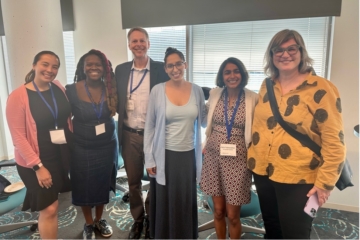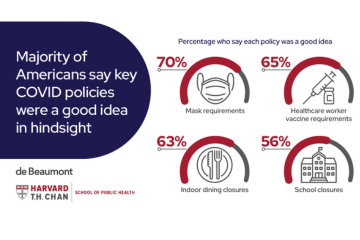
Nine months into the COVID-19 pandemic, we now know that much of the human and economic loss we have experienced in the United States was preventable. We know that face coverings, hand washing, limiting gathering sizes, and practicing social distancing are all successful interventions to reduce COVID-19 transmission and prevent infection. We know staying at home for enough time to contain the virus also works, but only if everyone does so despite the significant social and economic costs. And, we know not every American will comply with these containment measures and endure their related costs, even where it is mandated by local or state public health orders. As we learned after the summer holidays, those costs were indeed too high for many. Despite the risk of increasing infections in their communities, Americans were eager to “reopen” and move on from COVID-19 restrictions by going to restaurants, the gym, summer camp, and the hair salon; participating in or attending sporting events; traveling to the beach or elsewhere; and attending in-person religious services and events. Continued outbreaks, most recently in institutions of higher education as a result of students, staff, and faculty returning to campus for the fall semester, remind us we are on the virus’ timeline, not our own. As of November 2020, COVID-19 cases are sharply rising in almost all states and health officials are worried about hospital intensive care unit capacity and how this fall and winter’s influenza will comingle with COVID-19 in their jurisdictions. COVID-19 is far from over.
How did the richest nation in the world, with arguably the best health care resources on earth, fail to control a novel coronavirus despite knowing fairly early on in the epidemic how to prevent transmission and contain it? It is a simple question with a complicated answer, one that this supplement aims to help us better understand. The contributions to this supplement are focused on the early phases of the public health response to COVID-19, defined as January 21, 2020 (first confirmed case in the United States), to September 7, 2020 (Labor Day). It is important to describe these initial response insights and share the perspectives formed in the early response, not just to document the history of the COVID-19 pandemic in the United States but also to anticipate where our nation may be headed with this pandemic. If the past is prologue, COVID-19 response will continue to be complex, confusing, and ambiguous. Efforts to contain the virus and prevent its spread will continue to be met with significant public outrage and opposition in a time that demands unity and cooperation.
This supplement identifies and discusses a number of key themes drawn from early learnings from the COVID-19 pandemic.
COVID-19 amplified the health disparities and social inequities present in the United States prior to its emergence.
COVID-19 has disproportionally impacted individuals who could not “stay at home” to telework; individuals who lived in high-density housing; those who had low-paying or “essential” jobs in many sectors including hospitals, grocery stores, and meat-packing plants; and individuals with preexisting chronic illnesses such as heart disease or respiratory illness. Public health practitioners have long understood disparities in health status by race, ethnicity, and income. COVID-19 followed the trajectory of other diseases in the United States, with increased incidence among Black, Brown, and Latinx communities nationwide, as well as those in lower-income brackets. Not only does the burden of COVID-19 disease fall heavier on people of color and those with fewer resources, but also the COVID-19–related economic downturn similarly impacts these communities through business closures and job losses. COVID-19 highlights our nation’s racist history and contemporary inequalities, and it emphasizes the urgent need to address the social and economic conditions that keep people healthy, not just their individual access to health care. It is a sobering wake-up call about the margins on which many Americans live that a valid argument against school closures in our nation’s big cities was that a large number of American children would not have access to nutritious breakfast or lunch. It also suggests a real need to double down as a nation on fixes to the root causes of health that create these conditions in the first place.
COVID-19 response efforts elicited an extremely polarized political response among a small, but very vocal, minority of Americans concerned about government intrusion on their personal liberties.
This sentiment was most acute following Memorial Day 2020 when southeastern and southwestern states eased restrictions dramatically, as well as when the president continued to hold rallies and events despite his own positive test. Each of these events resulted in increased positivity and mortality. This sentiment was leveraged by political strategists to pit one party against another and undermined commonsense public health measures as a result.
In May, some governors, many aligned with the president, ignored or discredited the recommendations of local, state, and territorial health officials and quickly reopened bars, restaurants, hair salons, beaches, and gyms, only to have to close them soon thereafter when infections spiked and hospital admissions soared. Unprecedented public pushback against the mandated use of nonpharmacological interventions (eg, face covering use, physical distancing, gathering limits, business closures) in all states in the summer of 2020, often stoked by the same elected officials who reopened their states despite evidence that COVID-19 was not under control, is alarming and compromises our ability to control the spread of this virus and the next one in the future. A domestic terrorist plan to kidnap the governors of Michigan and/or Virginia as a consequence of their COVID-19 stay-at-home orders would have made a good thriller novel until it proved to be an actual plot the Federal Bureau of Investigation uncovered in October 2020.
Nationally, we are at a point where one’s political beliefs are a significant factor driving adherence to public health recommendations, not just risk of transmitting or being infected with this virus. Not wearing a face covering has become a statement about personal liberty, despite potentially infecting others; physical distancing is seen as a suggestion, not a helpful way to protect a loved one or neighbor; and public adherence to contact tracing and disease investigation efforts is declining overall in the name of privacy protection and freedom from government intervention. Public pushback against simple and effective ways to quickly control the pandemic in the United States is exacerbated and emboldened by the behavior of public figures who fail to support or adhere to critical public health guidance or suggest that personal responsibility is more important that our collective health security, starting at the very top of federal leadership in the Office of the President of the United States. Unfortunately, the fall of 2020 has begun to see the consequences of prioritizing politics over science: COVID-19 positivity rates are growing and hospital capacity in many areas is reaching a breaking point. As stated earlier, all of this could be prevented, especially given what we know now about COVID-19 versus in early 2020.
Almost 10 months into this pandemic, there has been no coherent national, federally led strategy to coordinate COVID-19 response activities across state and local jurisdictions. Other countries, although much smaller, such as South Korea, New Zealand, Singapore, and Taiwan, successfully contained COVID-19 through national planning and regional alignment with local health authorities. The lack of a coherent national approach in the United States is surprising: in every other major modern public health emergency, the US federal government has convened routine, predecisional, and deliberative meetings with local and state health officials to discuss policy changes, develop and revise guidance, and coordinate a national response that is primarily funded federally, managed by states, and implemented locally. In prior events such as Ebola, Zika, and H1N1, national organizations of public health leaders, such as the Association of State and Territorial Health Officials (ASTHO) and the National Association of County and City Health Officials (NACCHO), played a critical role in linking federal emergency operations centers and task forces with state and local health official members. In the COVID-19 response, local and state public health officials and their national organizations have not been actively consulted or engaged with federal response authorities, often learning about major policy changes or guidance revisions along with the general public through the media. The shipment of 150 million rapid antigen tests to nursing homes and schools in every state and territory was made known to state and territorial health officials through a US Department of Health and Human Services press release, with no guidance on their use in various settings, no plan to report the results of rapid tests to state and territorial health agencies, and no plan for future acquisition of the same tests when the 150 million were all used. As of today, boxes of these test kits still lie unused in jurisdictions that continue to struggle with when to use these rapid antigen tests with largely asymptomatic populations and how to apply and pay for the necessary waivers to use them outside of strictly controlled, CLIA-certified facilities.
Conflicting public communications from the White House, the US Department of Health and Human Services, the Food and Drug Administration, and the Centers for Disease Control and Prevention (CDC) have led to a dangerous erosion of public confidence in federal decision making and commitment to a robust local, state, and federal partnership. What should be a unified operational picture and shared strategy has been fragmented into different and varied state and local responses, with federal assets deployed to various local “hot spots” to support response activities, locations and recommendations changing weekly, and often without connectivity to local or state responders on the ground. One only need ask, “What’s our national ‘exit strategy’?” to see that no such national plan is, as of yet, in place.
Despite these troubling themes, significant opportunities for public health have emerged from the early period of the COVID-19 pandemic. For example, there is a renewed focus on the chronic underfunding of our local, state, federal, territorial, and Tribal public health systems and the need to build governmental public health capacity to prevent and respond to a host of threats, emergent and routine. As Sellers et al describe elsewhere in this supplement, there is no denying that more people know what their health department does today than they did 9 months ago and this can only help future efforts to build public support for enhancing our nation’s public health capacity in the future.1 Public health leaders are leveraging this crisis to define a more functional public health system in the future and to enumerate the workforce, funding, and other resources needed to sustain it. A record investment of $10.25 billion was appropriated to the CDC for state Epidemiology and Laboratory Capacity cooperative agreements as part of COVID-19 emergency funding. Overnight, the nation’s top and world’s premiere public health agency doubled its budget and quickly distributed the largest one-time investment in public health capacity building in history to every state and territory, 5 of our largest cities, and the largest Native American Tribal nation in the country. A $10 billion federal investment was made in a “warp speed” operation to develop a COVID-19 vaccine. Unfortunately, as of today, only $200 million has been appropriated to state and territorial health agencies to distribute it, far less than the estimated $5.5 to $6 billion needed according to CDC Director Robert Redfield or the $8.4 billion estimated by ASTHO.
The adage “never let a good crisis go to waste” speaks volumes about the moment the public health field is experiencing today. Public health leaders must work to pivot from a national narrative that public health interventions are at odds with liberty and economic prosperity: it is in fact a healthy society that creates the conditions for liberty and economic growth, not a sick one. Public health leaders also have to pivot toward a narrative supporting wellness and prevention: it is far easier and ultimately far cheaper to prevent diseases such as COVID-19 than to treat them. Whether local or state health officials are newly found celebrities or suffering notoriety by being erroneously tagged as public enemies, their leadership is needed and more important now than ever to end this pandemic. In a health system typically dominated by a narrative that focuses on medical care and tertiary prevention, public health and community leaders have to be willing to push an agenda focused on community health, primary prevention, and wellness. With all the talk of ventilators and vaccines, public health leaders must communicate that the best way to treat COVID-19 is to never get it in the first place.
The United States has not faced the challenges posed by a global pandemic such as COVID-19 for more than 100 years. The early response to this novel virus has demonstrated that prior planning did not sufficiently include adequate attention to the political ramifications of public health actions, nor did planners control for public officials willingly ignoring, weakening, and undermining public health authority to avoid the costs of economic instability or to bolster the odds of their reelection in such a profound and dangerous way. If public health leaders take away one lesson from the first 9 months of this pandemic, to paraphrase General Eisenhower, it should be this: Planning is essential but plans are useless. The reality of the COVID-19 response is that it has stressed and strained every part of the American society and far surpassed the capabilities of local, state, territorial, Tribal, and even federal public health agencies. Will we learn from the devastating early months of this pandemic and address the shortcomings and challenges COVID-19 raised before the pandemic worsens yet again, or will we repeat our mistakes in the future phases of this pandemic, failing to learn from even the recent past? The knowledge shared in this supplement can be instantly applied to the current public health response to COVID-19 and to help protect the health of all Americans. We sincerely hope it is.
This column first appeared with the title “COVID-19 and Public Health: Looking Back, Moving Forward” in the January/February 2021 issue of the Journal of Public Health Management & Practice. See the final authenticated version.




